Delta Electronics E804WAG Dual-Band Wireless A+G Router User Manual P74743 F6D3230 4 AG man 12 04 indd
Delta Networks, Inc. Dual-Band Wireless A+G Router P74743 F6D3230 4 AG man 12 04 indd
Contents
Users manual 7
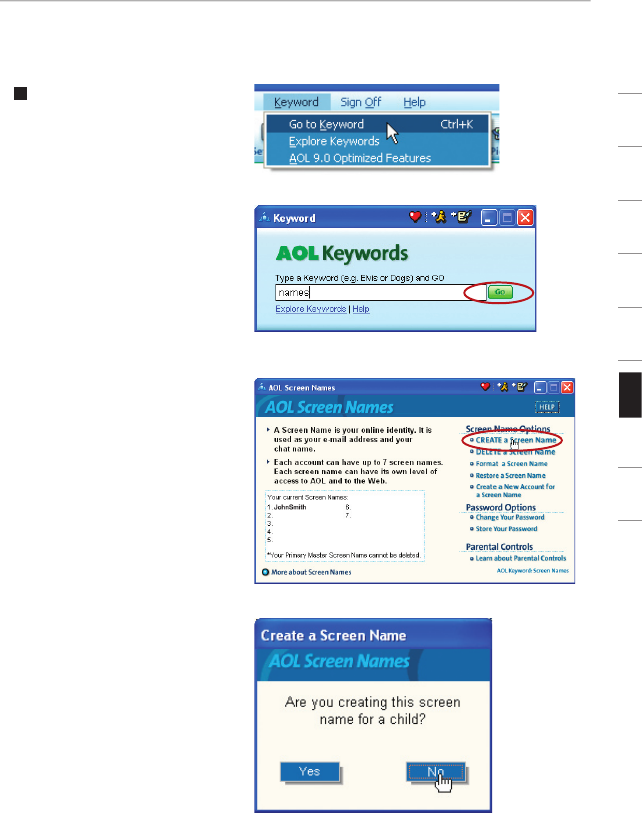
81
Setting up AOL for Broadband with the Router
section
1
2
3
4
5
6
7
8
9
3.
Perform a keyword
search on “names” by
clicking “Keyword”, and
then “Go to Keyword”.
4.
In the “Keyword”
window, type in
“names” then
click “Go”.
5.
You will see the
“AOL Screen Names”
window. Click “CREATE
a Screen Name”.
6.
A window will appear
that asks whether
the screen name is
for a child. If you are
creating the screen
name for the Router,
click “Yes” or “No” (it
doesn’t matter which
you select). If you
are creating a screen
name for an additional
computer, select the
appropriate answer.
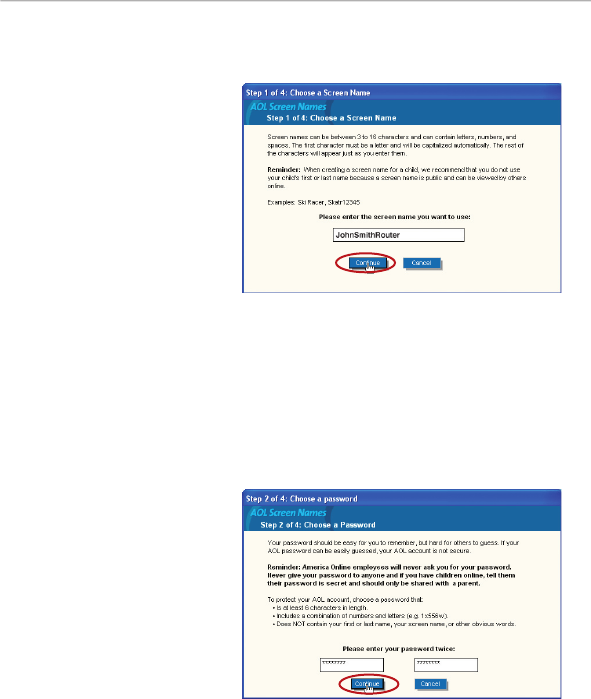
82
Setting up AOL for Broadband with the Router
Setting up AOL for Broadband with the Router
7.
The “Choose a Screen
Name” window will
appear. Type in a
screen name, and
click “Continue”. If
this screen name is for
the Router, the name
you choose should be
something like your
master screen name
followed by the word
Router. For instance
“JohnSmithRouter”.
If the screen name is
for a computer, type in
the screen name of the
computer for which you
are creating this screen
name. Click “Continue”.
8.
The “Choose a
password” screen
will appear. Enter the
password for this
screen name twice, and
click “Continue”.
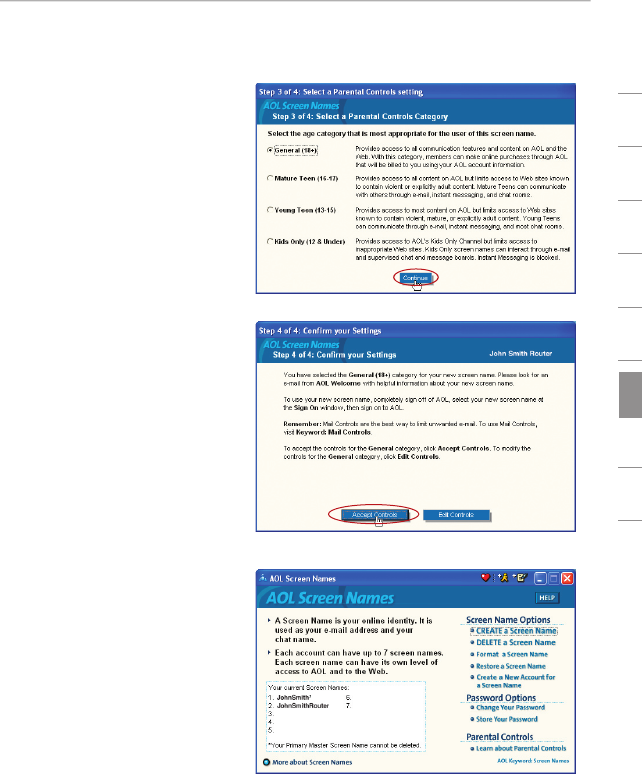
Setting up AOL for Broadband with the Router
83
Setting up AOL for Broadband with the Router Setting up AOL for Broadband with the Router
section
1
2
3
4
5
6
7
8
9
9.
The “Select a Parental
Controls setting”
window will appear. If
this screen name is for
the Router, choose any
one of the settings (it
doesn’t matter which).
If this screen name is
for a computer, choose
the desired setting and
click “Continue”.
10.
The “Confirm your
Settings” window will
appear. Select “Accept
Controls”.
11.
The “AOL Screen
Names” window
appears. This window
will include all the
screen names you have
created to this point.
12.
Repeat steps 1-11
to add an additional
screen name for each
computer that will be
using AOL and that will
be connected to the
Router. When you are
finished adding screen
names, go to Step 2.
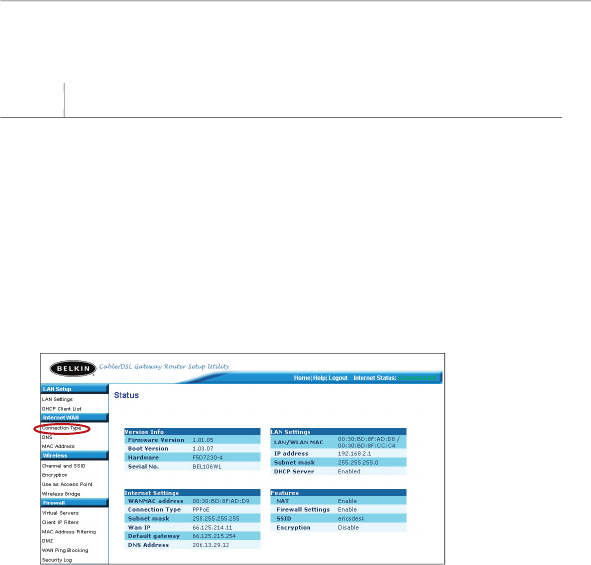
84
Setting up AOL for Broadband with the Router
Setting up AOL for Broadband with the Router
Step 2 Configuring the Router
Step 2 Configuring the Router
Connect your Router to your network per the instructions in your
User Manual.
1.
Open your web browser.
2.
In the address bar of your browser, type http://192.168.2.1 and
click “Go”. You will be directed to the Router’s home page. Click
on “Connection Type” in the left-hand column under the “Internet
WAN” heading.
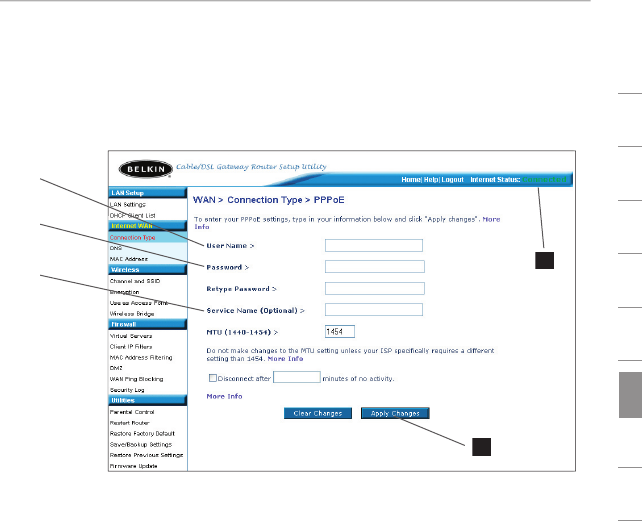
Setting up AOL for Broadband with the Router
85
Setting up AOL for Broadband with the Router Setting up AOL for Broadband with the Router
section
1
2
3
4
5
6
7
8
9
3.
You will see the Router’s login page. Leave the “Password”
field
(2)
blank and click “Submit”.
4.
You will now see the PPPOE setup page.
5.
In the “User Name” field
(1)
, type in the screen name that you
created for your Router
.
6.
In the “Password” fields
(2)
, type in the password you created for
the Router’s screen name
.
7.
Leave the “Service Name” field
(3)
blank
. Do not change the
MTU setting.
8.
Click on “Apply Changes”
(4)
.
9
. Click on the Home link at the top of the screen. The Internet
Status indicator should read “Connected”
(5)
.
10.
Go to AOL DSL Users Step 3.
(1)
(2)
(3)
(4)
(5)
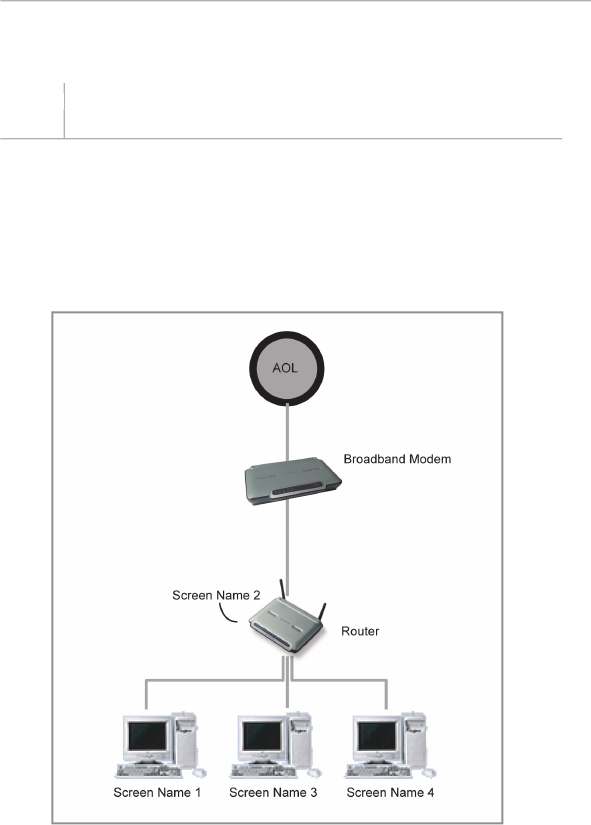
86
Setting up AOL for Broadband with the Router
Setting up AOL for Broadband with the Router
Step 3 Configure your computers with the AOL screen names
Step 3 Configure your computers with the AOL screen names
you just created
This step consists of installing the AOL software on each computer
and configuring it to use one of the screen names you created in
Step 1. Remember that each computer MUST use a different screen
name. For help installing and configuring the AOL software, contact
AOL’s technical support department.
Network Configuration
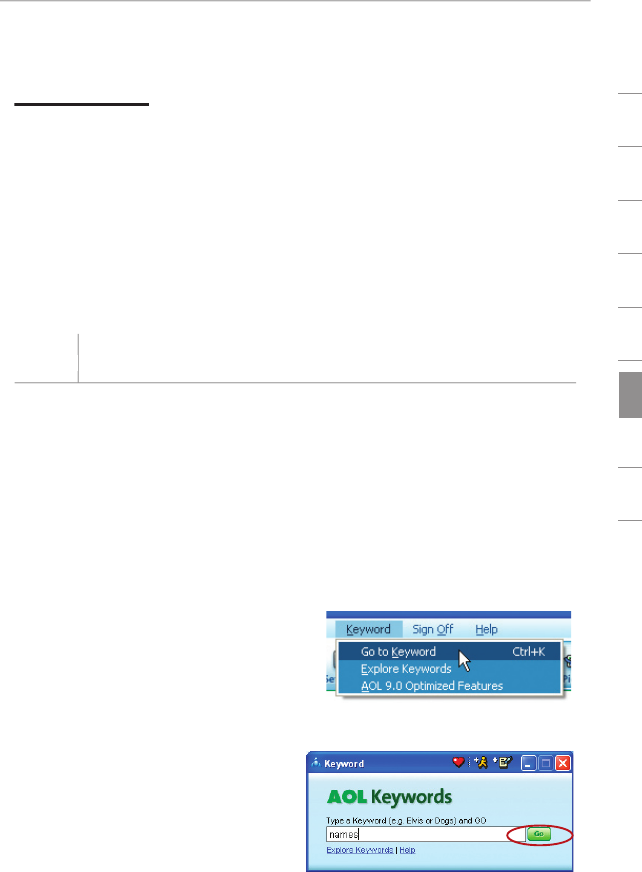
Setting up AOL for Broadband with the Router
87
Setting up AOL for Broadband with the Router Setting up AOL for Broadband with the Router
section
1
2
3
4
5
6
7
8
9
Directions for AOL Cable or AOL BYOA (Bring Your Own
Access) Users
Directions for AOL Cable or AOL BYOA (Bring Your Own
Access) Users
Directions for AOL Cable or AOL BYOA (Bring Your Own
AOL Cable users need to follow these directions. If you have AOL
DSL, go to the “Directions for AOL DSL Users” section beginning on
page 80.
STEP 1:
Create AOL screen names for each computer that will be using
your AOL service.
STEP 2:
Configure your computers with the new AOL screen names you
just created.
Step 1 Creating new AOL screen names
Note:
Your AOL connections must be set to operate on the TCP/IP
standard. If you have designated another protocol, reset them to
TCP/IP before proceeding.
1.
Connect the Router to the network per the instructions in your
User Manual. Once the Router is installed properly, go to the
next step.
2.
Log on to your AOL master account.
3.
Perform a keyword search
on “names” by clicking
“Keyword”, and then
“Go
to Keyword”.
4.
In the “Keyword” window,
type in
“names” then
click
“Go”.
Step 1 Creating new AOL screen names
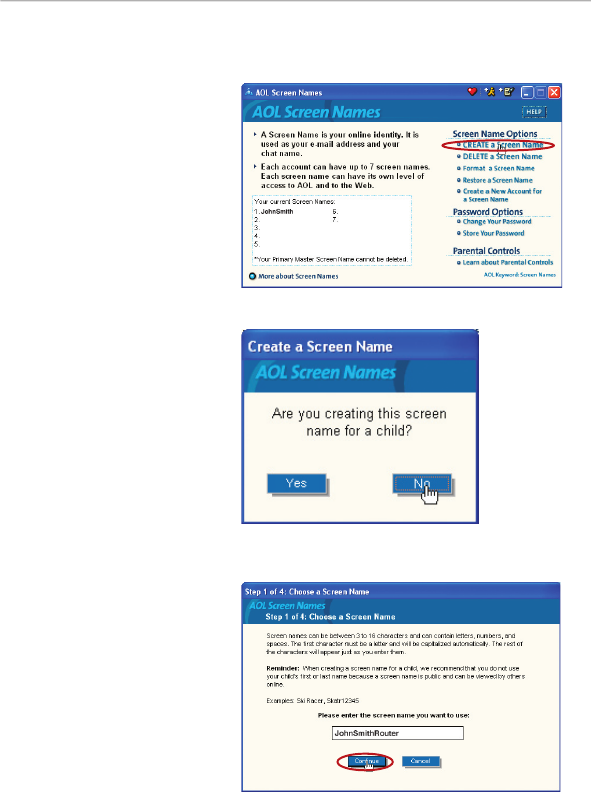
88
5.
You should see the
“AOL Screen Names”
window. Click “CREATE
a Screen Name”.
6.
A window will appear
that asks whether the
screen name is for a
child. Click “Yes” or
“No” to answer.
7.
The “Choose a Screen
Name” window will
appear. Type in the
screen name of the
computer for which you
are creating this screen
name. Click “Continue”.
Setting up AOL for Broadband with the Router
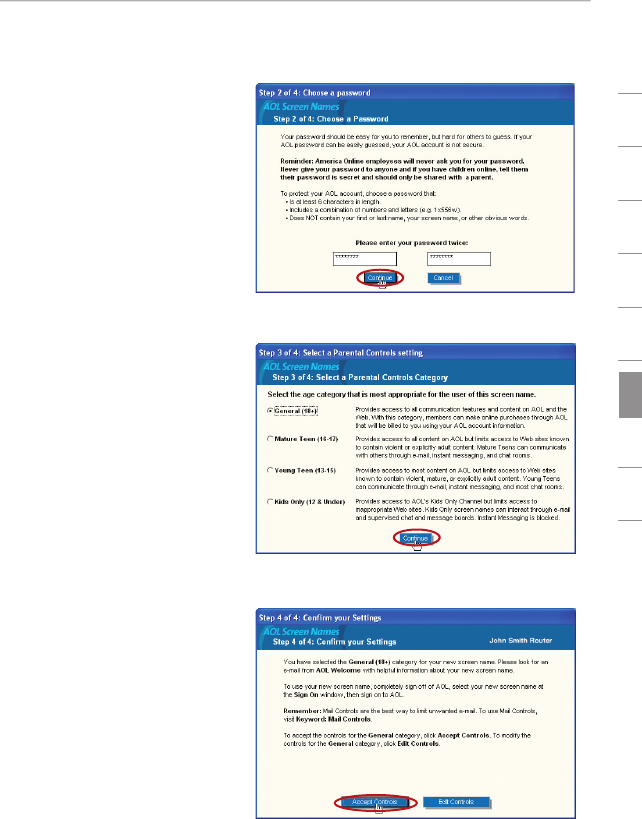
89
section
1
2
3
4
5
6
7
8
9
8.
The “Choose a
password” screen
will appear. Enter the
password for this
screen name twice, and
click “Continue”.
9.
The “Select a Parental
Controls setting”
window will appear.
Choose the appropriate
setting for this screen
name. Click “Continue”.
10.
The “Confirm your
Settings” window will
appear. Select “Accept
Controls”.
Setting up AOL for Broadband with the Router Setting up AOL for Broadband with the Router
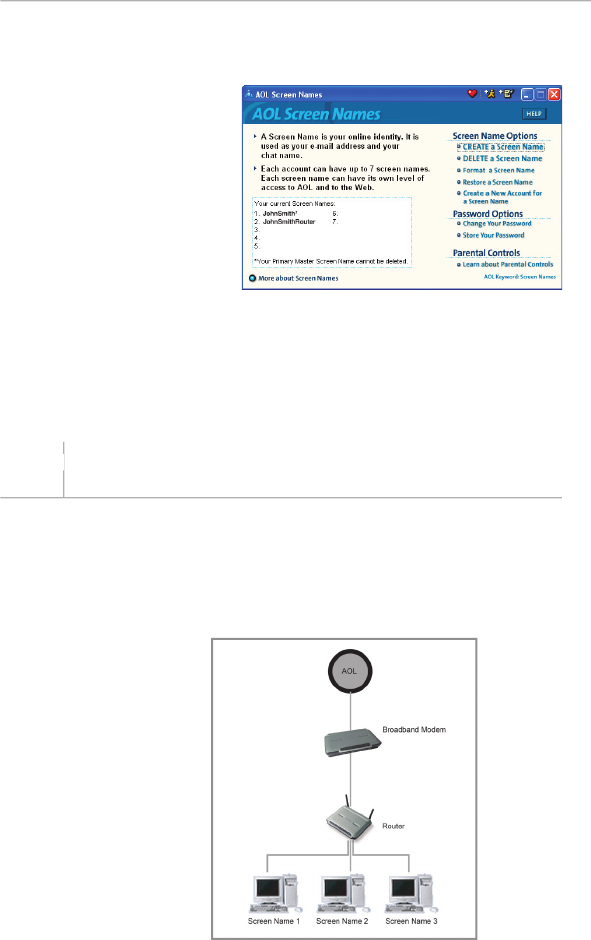
90
11.
The “AOL Screen
Names” window
appears. This window
will include all the
accounts you have
created to this point.
12.
Repeat steps 1-11 for
each computer that
will be using AOL and
that will be connected
to your Belkin Router.
When you are finished
adding screen names,
go to Step 2.
Step 2 Configure your computers with the new AOL screen names
Step 2 Configure your computers with the new AOL screen names
you just created
This step consists of installing the AOL software on each computer
and configuring it to use one of the screen names you created in
Step 1. Remember that each computer MUST use a different screen
name. For help installing and configuring the AOL software, contact
AOL’s technical support department.
Network Configuration
Recommended Web Browser Settings
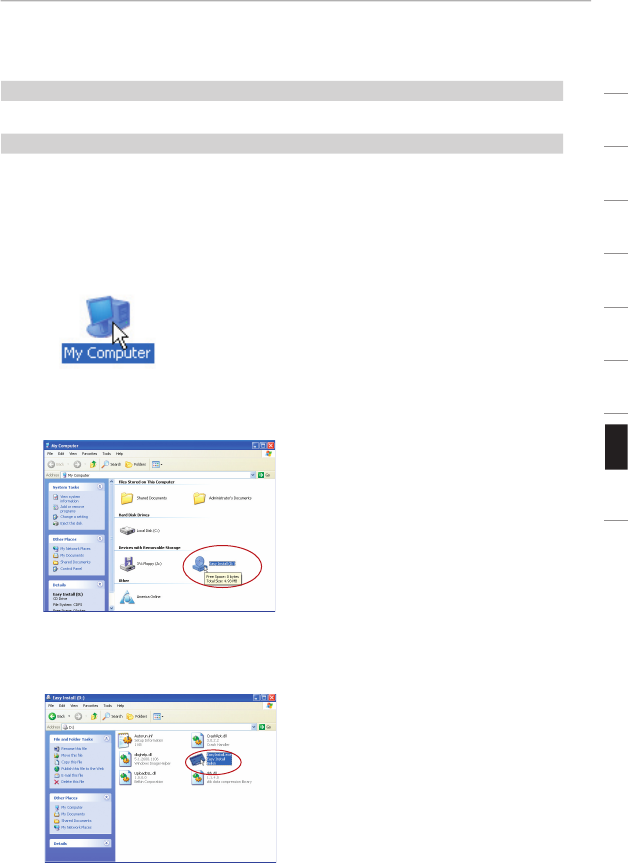
Troubleshooting
91
section
1
2
3
4
5
6
7
8
9
Problem:
Installation CD does not automatically start
Solution:
If the CD-ROM does not start the Easy Install Wizard automatically,
it could be that the computer is running other applications that are
interfering with the CD drive.
1.
If the Easy Install Wizard screen does not appear within 15-20
seconds, open up your CD-ROM drive by double-clicking on the
“My Computer” icon that is located on your desktop.
2.
Next, double-click on the CD-ROM drive that the Easy Installation
CD has been placed in to start the installation.
3.
Easy Install Wizard should start within a few seconds If, instead, a
window appears showing the files on the CD, double-click on the
icon labeled “EasyInstall.exe”.
If the Easy Install Wizard is still does not start, reference the section
titled “Manually Configuring Network Settings” (page 73 of this manual
for an alternative setup method).

92
Troubleshooting
Troubleshooting
Problem:
The
Easy Install Wizard cannot find my Router.
Solution:
If the Easy Install Wizard is not able to find the Router during the
installation process, please check the following items:
1.
If the Easy Install Wizard is not able to find the Router during the
installation process, there may be third-party firewall software
installed on the computer attempting to access the Internet.
Examples of third-party firewall software are ZoneAlarm,
BlackICE PC Protection, McAfee Personal Firewall, and Norton
Personal Firewall.
If you do have firewall software installed on your computer,
please make sure that you properly configure it. You can
determine if the firewall software is preventing Internet access
by temporarily turning it off. If, while the firewall is disabled,
Internet access works properly, you will need to change the
firewall settings to function properly when it is turned on.
Please refer to the instructions provided by the publisher of your
firewall software for instructions on configuring the firewall to
allow Internet access.
2.
Unplug power to the Router for 10 seconds, and then plug the
power back into the Router. Ensure that the
R
outer’s Power light
is on; it should be solid green. If not, check to make sure that
the AC adapter is connected to the Router and plugged into a
wall outlet.
3.
Ensure that you have a cable (use the cable included with the
Router) connected between (1) the network (Ethernet) port on the
back of the computer and (2) one of the LAN ports, labeled “1”
through “4”, on the back of the Router.
Note:
T
he computer should NOT be connected to the port labeled
“Internet/WAN” on the back of the
R
outer.
4.
Try shutting down and restarting your computer, then rerunning
the Easy Install Wizard.
If the Easy Install Wizard is still unable to find the Router,
reference the section titled “Manually Configuring Network
Settings” for installation steps.

Troubleshooting
93
section
1
2
3
4
5
6
7
8
9
Problem:
The
Easy Install
Wizard
cannot connect my Router to the Internet.
Solution:
If the Easy Install Wizard is not able to connect the Router to the
Internet, please check the following items:
Note:
If the Easy Install Wizard repeatedly displays an error message
that says it cannot make an Internet connection, you may have to
power cycle your modem in order to establish an Internet connection.
This step will allow the modem to reconfigure itself properly to work
with the Router. Please follow the instructions below:
Sequence:
1.
Unplug the power from
the
modem (supplied by your ISP).
2.
Unplug the power from your Belkin
R
outer.
3.
Wait for
five
minutes.
4.
Reconnect power to the modem.
5.
Wait for the modem to power up (about
one
minute, please
refer to the modem’s documentation).
6.
Reconnect
p
ower to the
R
outer.
7.
Check your Internet connection.
If your ISP requires a user name and password, make sure that you
have typed in your user name and password correctly. Some user
names require that the ISP’s domain may be at the end of the name.
Example: “myname@myisp.com”. The “@myisp.com” part of the user
name may need to be typed as well as your user name.
If you continue to have no Internet connection, reference the section
titled “Manually Configuring Network Settings” (page 73 of this
manual for an alternative setup method).

94
Troubleshooting
Troubleshooting
Problem:
• The Easy Install Wizard completed installation, but my web
browser doesn’t work.
• I am unable to connect to the Internet. The “WAN” light on my
Router is off, and the “Connected” light is blinking.
Solution:
If you cannot connect to the Internet, and the “WAN” light is off,
and the “Connected” light is blinking, the problem may be that your
modem and
R
outer are not connected properly.
1.
Make sure the network cable between the modem and the Router
is connected. We strongly recommend using the cable that was
supplied with your cable or DSL modem for this purpose. The
cable should be connected at one end to the Router’s “Internet/
WAN” port, and at the other end to the network port on your
modem.
2.
Unplug the cable or DSL modem from its power source for three
minutes. After three minutes, plug the modem back into its power
source. This may force the modem to properly recognize the Router.
3.
Unplug the power to your Router, wait 10 seconds, and then
reconnect the power. This will cause the Router to reattempt
communication with the modem.
If the “WAN” light on the Router is not lit after completing these
steps, please contact Belkin Technical Support.
4.
Try restarting your computer.
Problem:
• The Easy Install Wizard completed installation, but my web
browser doesn’t work
.
• I am unable to connect to the Internet. The “WAN” light on my
Router is on, and the “Connected” light is blinking.
Solution:
If you cannot connect to the Internet, the “WAN” light is on, and
the “Connected” light is blinking, the problem may be that your
connection type may not match the ISP’s connection.
• If you have a “static IP address” connection, your ISP must
assign you the IP address, subnet mask, and gateway address.
Please refer to the section entitled “Alternate Setup Method” for
details on changing this setting.

Troubleshooting
95
section
1
2
3
4
5
6
7
8
9
• If you have a “PPPoE” connection, your ISP will assign you a
user name and password and sometimes a service name. Make
sure the Router’s connection type is configured to PPPoE and
the settings are entered properly. Please refer to the section
entitled “Alternate Setup Method” for details on changing
this setting.
• You may need to configure your Router to meet the specific
requirements of your ISP. To search our Knowledge Base for
ISP-specific issues, go to: http://web.belkin.com/support and
type in “ISP”.
If you are still unable to access the Internet after verifying these
settings, please contact Belkin Technical Support.
Problem:
• The Easy Install Wizard completed, but my web browser
doesn’t work.
• I am unable to connect to the Internet. The “WAN” light on my
Router is blinking, and the “Connected” light is solid.
Solution:
If the “WAN” light is blinking, and the “Connected” light is solid,
but you are unable to access the Internet, there may be
third-party firewall software installed on the computer attempting
to access the Internet. Examples of third-party firewall software
are ZoneAlarm, BlackICE PC Protection, McAfee Personal
Firewall, and Norton Personal Firewall.
If you do have firewall software installed on your computer,
please make sure that you properly configure it. You can
determine if the firewall software is preventing Internet access by
temporarily turning it off. If, while the firewall is disabled, Internet
access works properly, you will need to change the firewall
settings to function properly when it is turned on.
Please refer to the instructions provided by the publisher of your
firewall software for instructions on configuring the firewall to
allow Internet access.
If you are still unable to access the Internet after disabling any
firewall software, please contact Belkin Technical Support.

96
Troubleshooting
Troubleshooting
Problem:
I can’t connect to the Internet wirelessly.
Solution:
If you are unable to connect to the Internet from a wireless
computer, please check the following items:
1.
Look at the lights on your Router. If you’re using a Belkin Router,
the lights should be as follows:
• The “Power” light should be on.
• The “Connected” light should be on, and not blinking.
• The “WAN Internet” light should be either on or blinking.
• The “Wireless” light should be on or blinking.
2.
Open your wireless utility software by clicking on the icon in the
system tray at the bottom right-hand corner of the screen.
3.
The exact window that opens will vary depending on the model
of wireless card you have; however, any of the utilities should
have a list of “Available Networks”—those wireless networks it
can connect to.
Does the name of your wireless network appear in the results?
Yes, my network name is listed
—
go to the troubleshooting
solution titled “I can’t connect to the Internet wirelessly, but my
network name is listed”.
No, my network name is not listed
—
go to the troubleshooting
solution titled “ I can’t connect to the Internet wirelessly, and my
network name is not listed”.
Problem:
I can’t connect to the Internet wirelessly, but my network name
is listed.
Solution:
If the name of your network is listed in the “Available Networks” list,
please follow the steps below to connect wirelessly:
1.
Click on the correct network name in the “Available
Networks” list.
2.
If the network has security (encryption) enabled, you will need to
enter the network key. For more information regarding security,
see the page entitled: “Setting
WPA
S
ecurity”
or
“Setting
W
EP
Encryption
”
.

Troubleshooting
97
section
1
2
3
4
5
6
7
8
9
3.
Within a few seconds, the tray icon in the lower left-hand
corner of your screen should turn green, indication a successful
connection to the network.
Problem:
I can’t connect to the Internet wirelessly, and my network name is
not listed.
Solution
If the correct network name is not listed under “Available
Networks” in the wireless utility, please attempt the following
troubleshooting steps:
1.
Temporarily move computer, if possible,
five
to 10 feet from the
Router. Close the wireless utility, and reopen it. If the correct
network name now appears under “Available Networks”, you
may have a range or interference problem. Please see the
suggestions discussed in the section titled “Placement of your
Router” of this User Manual.
2.
Using a computer that is connected to the Router via a network
cable (as opposed to wirelessly), ensure that “Broadcast SSID”
is enabled. This setting is found on the Router’s wireless
“Channel and SSID” configuration page.
If you are still unable to access the Internet after completing
these steps, please contact Belkin Technical Support.
Problem:
My wireless network performance is inconsistent.
Data transfer is sometimes slow.
Signal strength is poor.
I am having difficulty establishing and/or maintaining a Virtual
Private Network (VPN) connection.
Solution:
Wireless technology is radio-based, which means connectivity and
the throughput performance between devices decreases when
the distance between devices increases. Other factors that will
cause signal degradation (metal is generally the worst culprit) are
obstructions such as walls and metal appliances. Note also that
connection speed may decrease as you move farther from
the Router.

98
Troubleshooting
Troubleshooting
In order to determine if wireless issues are related to range, we
suggest temporarily moving the computer, if possible, five to 10 feet
from the Router.
Changing the wireless channel
-
Depending on local wireless
traffic and interference, switching the wireless channel of your
network can improve performance and reliability. The default
channel the
R
outer is shipped with is channel 11; you may choose
from several other channels depending on your region
.
S
ee the
section on page 42 entitled “Changing the Wireless Channel” for
instructions on how to choose other channels.
Limiting the wireless transmit rate
-
Limiting the wireless
transmit rate can help improve the maximum wireless range, and
connection stability.
Most wireless cards have the ability to limit
the transmission rate.
To change this property, go to the Windows
Control Panel, open the “Network Connections” and double-click on
your wireless card’s connection.
In the properties dialog, select
the “Configure” button on the “General” tab (Windows 98 users
will have to select the wireless card in the list box and then click
“Properties”), then choose the “Advanced” tab and select the rate
property. Wireless client cards are usually set to automatically
adjust the wireless transmit rate for you, but doing so can cause
periodic disconnects when the wireless signal is too weak; as a rule,
slower transmission rates are more stable. Experiment with different
connection rates until you find the best one for your environment.
Note that all available transmission rates should be acceptable for
browsing the Internet. For more assistance, see your wireless card’s
user manual.
Problem:
I am having difficulty setting up Wired Equivalent Privacy (WEP)
security on my Belkin Router (or Belkin Access Point).
Solution
1.
Log into your Wireless Router or Access Point.
Open your web browser and type in the IP address of the
Wireless Router (or Access Point). (The Router’s default is
192.168.2.1, the 802.11g Access Point is 192.168.2.254 ). Log
into your Router by clicking on the “Login” button in the top,
right-hand corner of the screen. You will be asked to enter your
password. If you never set a password, leave the “Password”
field blank and click “Submit”. Click the “Wireless” tab on the
left of your screen. Select the “Encryption” or “Security” tab to
get to the security settings page.

Troubleshooting
99
section
1
2
3
4
5
6
7
8
9
2.
Select “128-bit WEP” from the drop-down menu.
3.
After selecting your WEP encryption mode, you can type in
your hex WEP key manually, or you can type in a passphrase
in the “Passphrase” field and click “Generate” to create a WEP
key from the passphrase. Click “Apply Changes” to finish. You
must now set all of your clients to match these settings. A hex
(hexadecimal) key is a mixture of numbers and letters from
A-F and 0-9. For 128-bit WEP, you need to enter 26
hex characters.
For example:
C3 03 0F AF 4B B2 C3 D4 4B C3 D4 E7 E4 =
128-bit key
4.
Click “Apply Changes” to finish. Encryption in the Wireless
Router is now set. Each of your computers on your wireless
network will now need to be configured with the same
security settings.
WARNING:
If you are configuring the Wireless Router
(
or Access
Point
)
from a computer with a wireless client, you will need to
ensure that security is turned on for this wireless client. If this is not
done, you will lose your wireless connection.
Note to Mac users:
Original Apple Air
P
ort
®
products support
64-bit encryption only. Apple Air
P
ort 2 products can support
64-bit or 128-bit encryption. Please check your Apple Air
P
ort
product to see which version you are using. If you cannot configure
your network with 128-bit encryption, try 64-bit encryption.
Problem:
I am having difficulty setting up Wired Equivalent Privacy (WEP)
security on a Belkin Wireless Card.
Solution:
The Wireless Card must use the same key as the Wireless Router.
For instance, if your Wireless Router uses the key 0011223344556
6778899AABBCC, then the Wireless Card must be set to the exact
same key.
1.
Double-click the Signal Indicator icon to bring up the “Wireless
Network” screen. The “Advanced” button will allow you to view
and configure more options of your Card.
2.
Once the “Advanced” button is clicked, the Belkin Wireless
Utility will appear. This Utility will allow you to manage all the
advanced features of the Belkin Wireless Card.
3.
Under the “Wireless Network Properties” tab, select a

100
Troubleshooting
Troubleshooting
network name from the “Available networks” list and click the
“Properties” button.
4.
Under “Data Encryption”, select “WEP”.
5.
Ensure that the check box “The key is provided for me
automatically” at the bottom is unchecked. If you are using this
computer to connect to a corporate network, please consult
your network administrator if this box needs to be checked.
6.
Type your WEP key in the “Network key” box.
Important:
A WEP key is a mixture of numbers and letters from
A–F and 0–9. For 128-bit WEP, you need to enter 26
characters
.
This network key needs to match the key you assign to your
Wireless Router.
For
example:
C3 03 0F AF 4B B2 C3 D4 4B C3 D4 E7 E4 = 128-bit key
7.
Click “OK”, and then “Apply” to save the settings.
If you are not using a Belkin Wireless Card, please consult the
manufacturer’s user manual for that wireless client card.
Problem:
Do Belkin products support WPA?
Solution:
Note:
To use WPA security, all your clients must be upgraded to
drivers and software that support WPA security. At the time of
this publication, a security patch download is available, for free,
from Microsoft. This patch works only with the Windows XP
operating system.
You can find the patch to download from Microsoft by searching the
knowledge base for Windows XP WPA. Click on the “Downloads”
link. You will find a page entitled “Windows XP Support Patch for
Wi-Fi Protected Access”.
You also need to download the latest driver for your Belkin 802.11g
Wireless Desktop or Notebook Network Card from the Belkin
support site. Other operating systems are not supported at this
time. Microsoft’s patch only supports devices with WPA-enabled
drivers such as Belkin 802.11g products.
Download the latest driver at
http://web.belkin.com/support